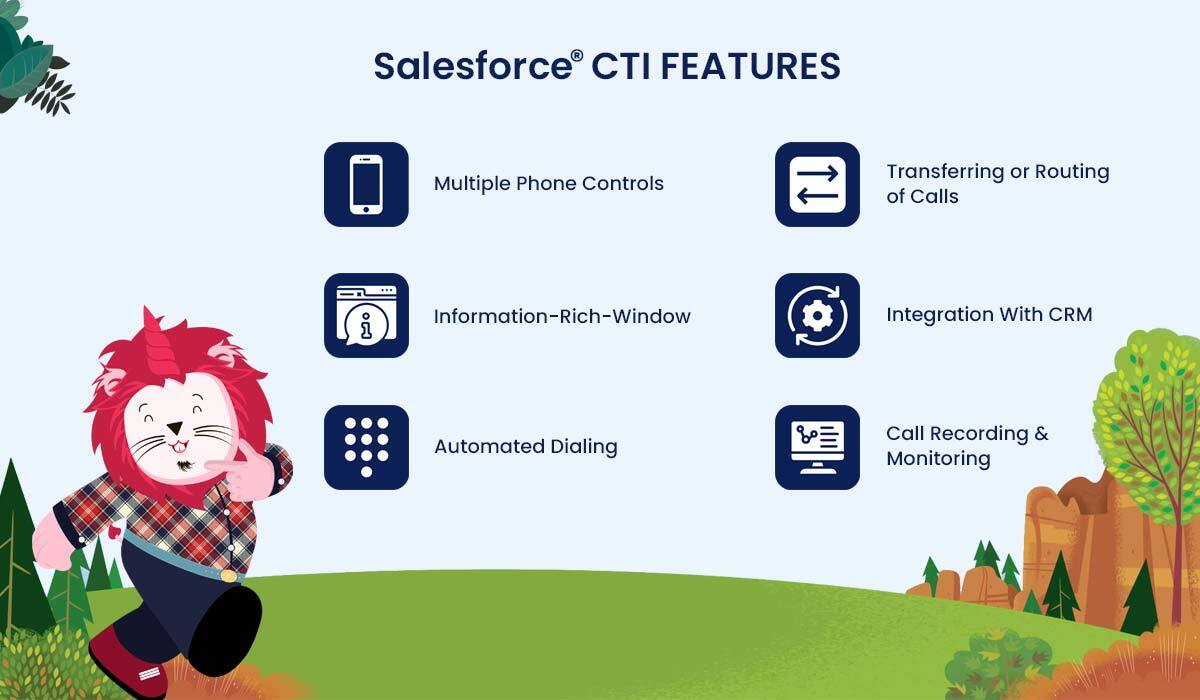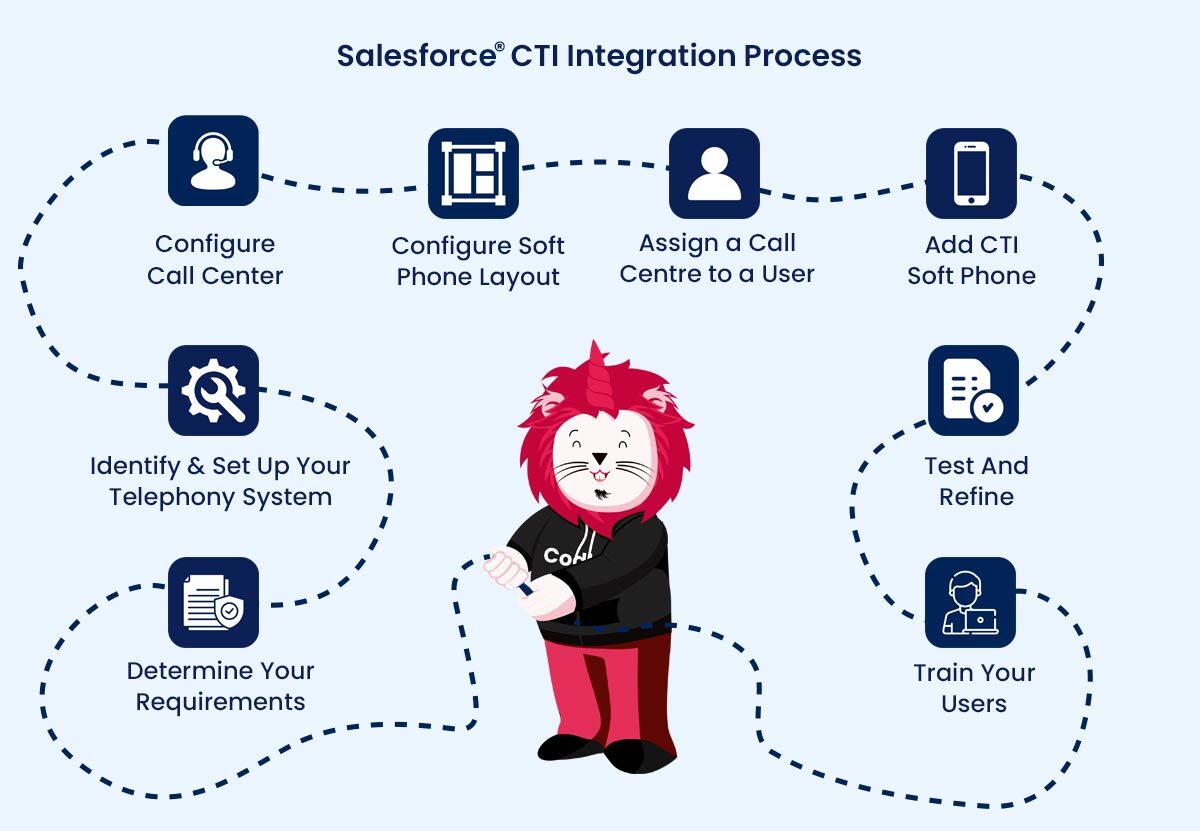Publish date:
Do you need help keeping your customers engaged and satisfied with your business? You are not alone. Many companies face the challenge of consistently delivering the expected experience to their customers.
You must meet customer expectations to maintain valuable customers and maintain your reputation. Leveraging the right tools to provide a seamless and personalized experience is essential to improve customer engagement.
This is where computer telephony integration (CTI) can make a significant difference. CTI integration, mainly through leading platforms, can significantly assist your agents and enhance customer relationships.
Managing extensive data responsibilities becomes crucial as your operations and client base grow. Your CRM can store and manage records of prospects and clients, including their order history, past conversations, basic details, and more. However, there is even more potential to be unlocked.
A key concern is understanding how to effectively integrate CTI into your service processes. Additionally, it is essential to grasp what CTI is and how it can benefit your business.
This blog will address all your queries about CTI. You will comprehensively understand CTI, its features, functionality, and benefits. Moreover, you will learn about integrating CTI into your service operations.
What Is CTI?
Computer Telephony Integration (CTI) is a technology that enhances customer service by integrating a telephone system with a computer or softphone. These integrations often utilize VoIP (Voice over Internet Protocol) to facilitate voice and online communication.

CTI enables data transmission between systems, allowing users to make and receive calls, track conversation history, and log call information within a CRM system.
Initially popularized by call centers, CTI connected phone systems to their software, allowing customer service agents to interact with customers via desktop-based interfaces. This technology also eliminated the need for physical phone devices, as agents could perform all phone-related functions using on-screen call controls.
Now that we have a basic understanding, let’s continue exploring computer telephony integration or CTI for Salesforce.
CTI For Salesforce
Salesforce CTI simplifies the concept of CTI by embedding it within Salesforce. This integration allows representatives to make phone calls or engage in conversations using the data stored in Salesforce. Critical features of Salesforce CTI include:
-
Automatic transcription of phone conversations.
-
Automatic routing of incoming calls to the appropriate recipient.
-
Real-time display of account or customer information.
-
Click-to-dial or auto-dialing features embedded within the Salesforce interface.

When making or receiving calls through Salesforce CTI, agents can access the caller’s details from their database, saving time and enabling them to address customer concerns directly by reviewing the customer’s history.
Salesforce Open CTI allows for integrating third-party CTI systems with Salesforce’s call center. This integration supports automatic call routing to the appropriate departments and enables recording incoming and outgoing calls to generate real-time analytics and reports.
By using Salesforce CTI Integration, businesses can generate real-time performance reports for employees and log all incoming and outgoing calls to gain insights into customer requirements.
Salesforce CTI integration is a powerful tool for implementing Salesforce in your organization. To explore other integration possibilities, refer to our comprehensive Salesforce integration guide.
CTI Features
Computer Telephony Integration (CTI) enables the making and receiving of calls and extends its functionalities significantly. Here are some key features:

Multiple Phone Controls
CTI equips agents with various phone control features such as making or receiving calls, holding, muting, merging, hanging up, and forwarding. By consolidating all these functions in one place, agents can manage their tasks efficiently without switching between phone and computer systems. This setup allows agents to focus more on customer interaction and call management.
Information-rich Window
When a customer calls, a window automatically appears on the agent’s screen, displaying all the stored information about the caller. This automated screen provides essential details, such as caller authentication via Automatic Number Identification (ANI) or Dialed Number Identification Service (DNIS), call history, and data of other customers. This resource availability enables agents to deliver more personalized and efficient customer service.
Automated Dialing
CTI offers several automated dialing features, including predictive dialing, click-to-call, and auto-dialers. Predictive dialing is a time-saving tool for bulk or automatic dialing multiple phone numbers, routing the call to a live agent once a connection is established. The click-to-call feature allows customers to initiate a call to a service representative by clicking a link within an application, advertisement, or website. These automated dialing features enhance agents’ productivity and streamline task management.
Transferring or Routing of Calls
CTI facilitates data-oriented call transferring or routing through an Automatic Call Distributor (ACD). This system cross-checks information from inbound calls against the company’s database and routes the call to the most suitable agent. For example, if a customer inquires about a refund status, the CTI software identifies and connects them to an agent specializing in that area. This functionality accelerates issue resolution and enhances customer satisfaction.
Integration with CRM
Teams can seamlessly access comprehensive customer data by integrating the CTI system with a CRM platform. This integration can extend to contact center platforms, unified communications, or VoIP PBX phone systems. Consequently, agents can view all caller information, including previously stored data, facilitating smoother communication and timely issue resolution.
Call Recording and Monitoring
CTI tools can be invaluable for call recording and monitoring. Agents can review previous call recordings to understand the context of customer issues and deliver personalized solutions. Ongoing calls can be observed to evaluate agent performance effectively. Disputes can be resolved, and new employees can be trained. Managers and trainers can join calls in real-time for guidance and support.
These features make CTI essential for enhancing customer service efficiency and effectiveness.
How Does CTI Work?
Most CTI software operates on VoIP, transforming your computer into an extension of your phone. This integration works seamlessly with your company’s software, allowing agents to access customer data with a single click, enhancing interactivity during calls.

Here’s a simplified process in two steps:
Integration and Caller Identification
CTI features can integrated into your website or application with minimal coding. This integration allows agents to quickly identify the caller’s phone number and click on it to initiate a call directly from the phone app, eliminating manual dialing.
Enhanced Call Management
With CTI, agents can make and receive calls while accessing customer information and phone controls from the same screen. This functionality is invaluable for contact center agents and managers who require call monitoring and visibility. For example, CTI systems can provide advanced phone controls such as muting, transferring, pausing, recording, and holding. The system automatically collects valuable information like the date, time, call duration, and call origin.
As CTI features reveal their full potential, recorded and stored information in the CRM, ERP, or ticketing system database allows managers and experts to generate reports and analyze business performance and employee efficiency. This analysis helps identify the services delivered to customers and areas for improvement.
CTI software enhances call management and customer service by following these steps, providing comprehensive data and insights for continuous improvement.
Salesforce CTI Integration: Step-by-step Guide
The process of Salesforce CTI integration involves the following steps:

Step 1: Determine Your Requirements
Before starting the integration process, it is crucial to identify your specific needs and requirements. Establishing these requirements will help you choose the right CTI system for your organization and ensure it aligns with your business objectives.
Step 2: Identify & Set Up Your Telephony System
Before integrating your telephony system with your CRM, you must set it up and configure it according to your requirements.
Step 3: Configure the Call Center
Upload the telephony provider web app XML, which contains the necessary configuration information for connecting the call center to the telephony provider web application. Enable the desired features in the CTI system.
Step 4: Configure Softphone Layout
Customize the softphone layout to enable call redirection to current customers, new leads, contacts, and accounts. The softphone layout is a customizable interface that provides call controls and caller information during calls. You can add call redirection options on the softphone layout canvas and tailor it to your brand preferences, ensuring no data entry errors and maintaining accuracy in customer interactions.
Step 5: Assign a Call Center to Users
Assign the call center to the relevant users, allowing them to perform inbound and outbound calls through the CRM using the telephony provider system. Once assigned, users can access essential call controls and caller information within the CRM, helping manage and track each customer interaction efficiently. The softphone layout will display all relevant caller information, and call controls will enable users to handle calls and associated tasks seamlessly.
Step 6: Add CTI Softphone to the Application
Integrate the CTI softphone into the application utility bar. The CTI softphone displays caller information and call controls, allowing users to manage calls without switching between windows and applications within the CRM.
Step 7: Test and Refine
After completing the integration, it is essential to test and refine the system as needed. This includes testing call flow, routing, handling, and making necessary adjustments to ensure the system operates optimally.
Step 8: Train Your Users
Finally, train your users to use the CTI solution, including making and receiving calls, logging calls, and accessing customer information.
Integrating CTI requires careful planning and execution to ensure a successful outcome. Working with a partner or consultant is recommended to guide you through the process and provide a smooth integration.
Salesforce CTI Benefits

After completing this straightforward integration process, consider the advantages you can gain as a business and as a Customer Service Representative, enabling you to achieve various goals:
1. Efficient Handling of Calls
Integrating CTI into your CRM system significantly reduces the manual effort required by agents to manage information and calls. The integrated dial-pad allows agents to quickly find contacts or tap on numbers displayed on their screen to initiate conversations. It eliminates the need to switch between tabs or windows or use a separate dialer, streamlining the process into one seamless experience.
2. Improved Customer Service and Increased Satisfaction
CTI tools indirectly enhance customer service quality and increase customer satisfaction. With CTI, agents can quickly access caller information and understand the purpose of the call. Having access to previous phone calls and customer information., agents are well-prepared for interactions. This "multi-channel" or "omnichannel" approach ensures that valuable information is readily available, reducing the need for customers to repeat themselves and preventing frustration. It leads to fewer calls and an improved overall customer experience.
3. Flexibility with Software and Hardware
CTI systems offer a hassle-free solution for remote customer support, eliminating the need for additional hardware or software setups. Integrated into your CRM platform, agents only need to log in via their web browser to start working, simplifying the process for your IT team. Additionally, CTI systems allow control over microphones and headsets, making them suitable for remote and in-office agents. This ease of use streamlines the onboarding process, benefiting everyone, from support staff to IT supervisors and agents.
4. Ease in Tracking Performance
CTI systems enable recording inbound and outbound calls, allowing managers to monitor agent interactions with customers. With analytics tools, it is easy to gain insights into customer behavior, identify trends, and generate performance reports. This tracking capability helps evaluate and improve the effectiveness of customer service operations.
By leveraging these advantages, businesses can enhance their customer service operations and achieve higher efficiency and satisfaction levels.
Salesforce CTI Pricing
The cost of integrating Salesforce Computer Telephony Integration (CTI) varies based on business size and the number of users. CTI is a feature in Salesforce Service Cloud, but it is only available in the Professional, Enterprise, and Unlimited editions.
The functionality and capabilities of Salesforce Open CTI can vary with each edition, potentially offering additional features.
Moreover, some third-party vendors provide alternative CTI solutions that are compatible with Salesforce. These options have pricing models that offer flexibility for different business needs.
Wrapping It Up
In conclusion, integrating Salesforce CTI can significantly streamline communication and enhance your business's customer experience. This integration empowers your team to efficiently resolve customer queries, complaints, and requests, ensuring customers receive the necessary answers.
For the best results, consider partnering with an experienced Salesforce Integration Partner. An expert who has successfully handled numerous Salesforce CTI integrations can effortlessly navigate any potential obstacles, making the integration process smooth and efficient.
Why wait any longer to optimize your communication processes? Please schedule a consultation with us today and discover how our expertise in Salesforce CTI Integration can transform your customer interactions.
Contact Codleo Consulting now to get started!
















